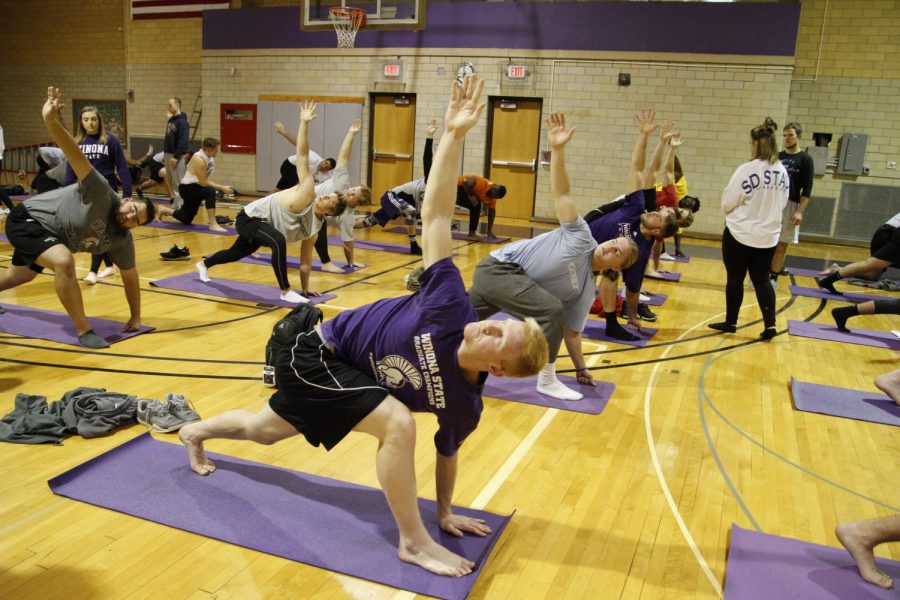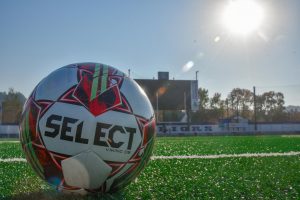RoFlow program aids student athletes
Members of the Winona State football team participate in the Restorative Flow Movement Pattern program which was designed to help athletes recover from hard practices or injuries.
October 31, 2018
A team of collegiate football players practicing usually does not involve yoga mats and a yoga-like routine, including athletes standing on their heads, but at Winona State University, that is the usual.
The Winona State football team has been integrating a program called RoFlow, Restorative Flow Movement Pattern, into the training regimes of the athletes. This unique training method helps athletes to be better equipped with a skill set to recover quicker and more efficiently after hard training or injury.
Connie Mettille, a health, exercise and rehabilitative sciences (HERS) professor at Winona State, works closely with the Winona State football team doing year-round RoFlow training twice weekly.
“RoFlow is training the body in specific movement patterns to prevent injury and to build stability and vitality in the body,” Mettille said. “It is taking nonspecific movement patterns to build chains in the human body to protect it from injury. Especially in sport specific movements like football this program helps keep our athletes as healthy as they can be,” Mettille said.
Mettille has also worked with the men’s and women’s basketball, soccer and the track and field teams at Winona State but focuses primarily on the football team.
“The football team have put parts of the RoFlow training into their everyday warm-ups out on the field as well. We have seen a huge reduction in soft tissue injuries and we have minimized many sprains and injuries,” Mettille said. “Because football is such a violent sport, we can never eliminate some injuries in the sport, but we have reduced the number of injuries significantly,” Mettille said.
Winona State is not the first to introduce the RoFlow program into their everyday training, the four core sports, NFL, NBA, NHL and the MLB, all use this program as well.
“We are not the first people to do it, but we are loving watching these athletes develop in a whole new way. We try to help them move better because when the human body moves better it can move faster, longer and in more unique positions which all just make for a better athlete,” Mettille said. “And we love bringing in that mental focus. In this age with how much stress everyone is under it is so important to have a coaching staff that values their athlete’s mental health and wellbeing.”
The RoFlow program has been beneficial in not only training the athletes bodies to be better physically but also in training the athletes’ minds.
“The beautiful part of the program is this secondary benefit of awareness and training of the brain,” Mettille said. “This is hard work physically and mentally, we are constantly drawing attention back to breath and how the breath can help the human body do more than it thinks it can,” Mettille said.
RoFlow was started at Winona State six years ago to reach the teams three goals: reduce the number of injuries, get people back on the field after an injury and recover from training faster.
“It is super fun and super funny because you take these incredibly talented athletes and you put them into these positions that you wouldn’t think their bodies can do. They are amazingly agile, and strong, so when you mix that together with mindfulness it becomes a really beautiful and a funny thing,” Mettille said. “Football players are known for the strength of their bodies so seeing them do this style of training has been really special and rewarding.”
Adrian Harmsen, senior geoscience teaching major at Winona State, has played football throughout middle school and high school and now in college. In middle school and high school Harmsen played running back, but now at Winona State he plays cornerback.
Harmsen has been a part of the RoFlow program since his first-year at Winona State and talked about the benefits of the practices.
“RoFlow has definitely benefited myself and the team as a whole. One of the biggest noticeable differences is the overall range of mobility. Being more flexible really helps our team anywhere from an increase in speed with ankle mobility, to creating more power from great shoulder mobility and even balance. Most importantly, it has helped us stay on the field from prior injuries like pulled or strained muscles,” Harmsen said.
The RoFlow program also benefits students in the HERS program at Winona State as well.
Mettille trains about 80 HERS students so they can help the football team during RoFlow. The training helps the HERS students practice what they will do in the field after graduation and also creates a connection between the football team and the trainers.
“Students are there to help adjust us if we are out of position and will assist us to get a deeper stretch if we need it. It is also a great experience for the students to get hands on experience to further their learning and future careers,” Harmsen said. “I just want to say thanks to the RoFlow students and staff for their time commitment to help better us as players. It does not go unnoticed and we are grateful for every minute.”
Mettille spent years getting certified to be able to teach RoFlow to athletes at Winona State. There were a lot of training and certifications Mettille had to pass to get to the position she is in now. Mettille also has strength training background and FMS, functional movement systems, to help benefit the RoFlow program.
Mettille has presented research done on RoFlow and FRAME(Facilitators of Recovery and Movement Enhancement) with Justin Geijer, a HERS professor at Winona State, at multiple conferences over the last three years. This research helps other athletic teams learn about the healing benefits of RoFlow.
“Although, it is of course another time commitment in our busy schedules and some sessions can actually get difficult for us to do, we as players know it is beneficial to us as individuals and to our team to get that win on Saturday,” Harmsen said.













































